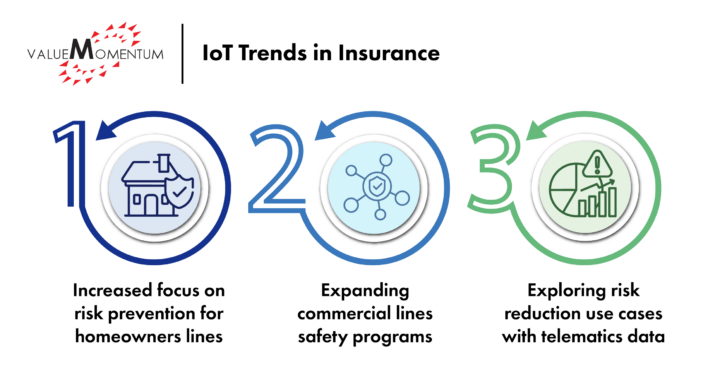While telematics in personal auto continues to offer insurers opportunities to reduce claims costs, boost customer satisfaction, and improve their loss ratio, it is far from the only form of IoT that can help insurers reach their growth goals. For example, in the last couple of years, numerous insurers have started leveraging smart home sensors in homeowners lines for fire prevention and flood monitoring.
Whether a carrier has a robust telematics program or is just entering the fray, emerging use cases for IoT technology can lead to profitable outcomes. How are insurers applying IoT? In what areas of the insurance value chain? What are challenges and potential benefits? Here are three trends to watch based on insights from insurance leaders in emerging tech.
Beyond Telematics: Key Trends in IoT in Insurance
The most forward-thinking insurers are already starting to look beyond telematics and explore ways to leverage other forms of IoT-powered programs.
Beyond the technology aspect of these initiatives, carriers are investigating how they can better involve agents in the IoT adoption process and educate both agents and customers about the benefits various forms of IoT can have not just on premiums but on safety and risk reduction outcomes.
Key trends insurers should be keeping their eyes on include:

- Increased focus on risk prevention for homeowners lines
While telematics applications in homeowners have been a key topic of exploration since for the better part of a decade, only a few insurers, like State Farm, successfully scaled their connected home portfolio until now. But the market is following those few insurers and investing in telematics and connected devices that can help homeowners and their insurers prevent small issues from becoming major problems.
“While only State Farm has grown a big portfolio in this space, it’s already clear that this trend is taking off,” Matteo Carbone, Founder of the IoT Insurance Observatory, noted. “Nationwide has also grown its portfolio in this space, and there are at least ten carriers working to replicate what these leading insurers have done. Currently, the focus is mainly on prevention with respect to fire hazards and water shutoff valves, which may be mandated above a certain threshold of value, for example.”
- Expanding commercial lines safety programs
As with personal lines, carriers are moving past just offering telematics-based premium incentives for fleets. “Progressive is leading in personal lines, but last year the company shared that more than 13% of its commercial auto portfolio is based on telematics,” Carbone shared. “Carriers are trying to copy Progressive’s approach and dedicating significant activity to setting these programs up. For example, more than 20% of Philadelphia Insurance’s fleets are equipped with a dongle to monitor driving behavior and help improve the safety of its fleets.” Other insurers are also working on similar initiatives.
In addition to commercial fleets, a handful of large insurers, including Hanover and Hartford Steam Boiler, have successfully added IoT-powered safety programs into their portfolios that focus on monitoring commercial properties with connected devices. While the level of maturity in these areas remains low across the industry, these insurers are investing in growing their program sizes exponentially.
“IoT investments in the commercial insurance space are helping carriers and their customers not only track their current efficiency levels but also make adjustments to improve their business,” said David Kuhn, ValueMomentum’s AVP of Emerging Technologies. “For instance, in manufacturing, companies are entering an era known as Industry 4.0. By leveraging connected machines, data from those devices, and human experts, companies are able to see how effectively their shops run. Making that data available to carriers can help create a ‘health score’ that can assist both in pricing and in loss management.”
- Leveraging telematics data to explore other risk reduction use cases
Insurers have grown more comfortable with how to apply IoT technology to their workflows, and data collection, analysis, and usage has improved across the industry. These two trends have converged to increase the maturity of carriers’ IoT usage. Now, not only do insurers have IoT and telematics data, but they also have the architecture to process it and derive insights from it.
“In the past, insurers’ technology infrastructure was not sophisticated enough to acquire, store, process, and analyze sensor and telematics data,” shared Kott Sivakumar, ValueMomentum’s SVP of Enterprise IT. “However, with sustained investments in cloud infrastructure over the last few years, combined with the evolution of architecture patterns like edge and fog computing, insurers are not only able to incorporate IoT data into their core workflows, but they are able to do so in a manner that enables them to provide a seamless user experience.”
With the increased appetite to learn from IoT data, insurers are cultivating additional use cases. In Europe, for instance, a medical malpractice insurer is adding cameras in operating rooms and providing real-time suggestions to the medical team. In addition, a specialty carrier has introduced a dedicated coverage for lithium ion battery energy storage systems, which mandates the usage of the insurer’s certified, IoT-based safety program. More use cases will continue to emerge as the maturity rates in this area grow across the insurance market.
As carriers continue to explore further use cases for telematics and IoT in insurance, they should keep a few best practices in mind. Rather than getting distracted by shiny new technologies that emerge in the marketplace, our emerging tech experts encourage carriers to think big, collect all of the business requests from stakeholders across the enterprise, but start with a focus on a few robust use cases with a targeted approach.
Focusing on an approach that starts small and shows strong results has yielded greater success for carriers. Taking these efforts one niche at a time helps because when an innovation team has one profitable use case on their hands, they are much more likely to receive investment in a second project. As insurers continue to invest in IoT, the industry is poised to see developments across a wide range of lines of business, from legal malpractice to manufacturing.
To learn more about driving results with telematics, read this article from Carbone and ValueMomentum in Telematics: The Secret to Lower Combined Ratios and a New Model for Auto Insurance.
